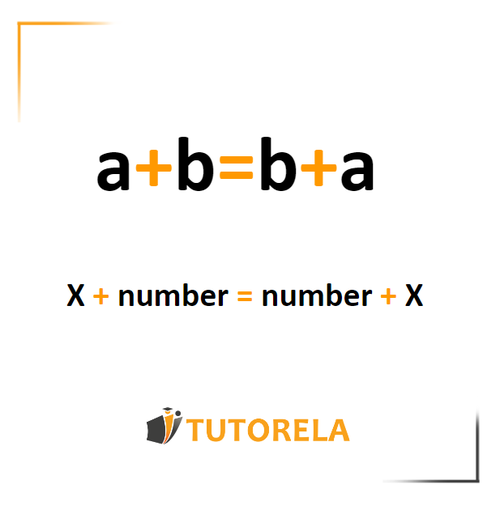Let's see an example
Task:
X+7=7+X
We will replace X with a number:
X=4
We get:
4+7=12
As you can see, it doesn't matter in what order we add the addends, we still get the same correct answer.
Note that the commutative property of addition does not work with subtraction.
As you practice using this property, you might find yourself starting to use it almost automatically- that's great! The commutative property will continue to be a helpful tool as we progress in our math career.
Exercises with the Commutative Property of Addition
Exercise 1
Task:
(41+47−45−41)⋅10:7:5=?
Solution:
Pay attention to the equation in parentheses - you'll notice that the fourths cancel eachother out.
(47−45)⋅10:7:5=
We then look at the equation outside the parentheses, we will move the 5 in order to divide by 10.
(47−45)⋅10:5:7=
We find the common denominator for the fraction and solve the exercise according to the order of operations.
47−5⋅2:7=
42⋅2:7=
21⋅2:7=
Simplify by 2
1:7=71
Answer:
71
Join Over 30,000 Students Excelling in Math!
Endless Practice, Expert Guidance - Elevate Your Math Skills Today
Exercise 2
Task:
432+272+331+173=?
Solution:
First, we reorder the expression, using the commutative property, to see the common denominators next to eachother.
432+331+272+173=
Then, we add the fractions with common denominators and then the whole numbers.
32+31=1
4+3=7
72+73=75
2+1=3
Solve the equation.
7+1+375=
8+375=1175
Answer:
1175
Exercise 3
Task:
113+59+71+57=?
Solution:
First we add 59 and 71, in order to get a round number and make the rest of the equation simpler.
113+130+57=
Now we add 113 and 57 to get another round number.
130+170=300
Answer:
300
Do you know what the answer is?
Exercise 4
Task:
7+4+3+6=?
Solution:
We reorder the numbers in the exercise in order to get round numbers that will make the expression simpler.
7+3+6+4=
We add 7 and 3, and then 6 and 4, so we get
10+10=20
Answer:
20
Exercise 5
Task:
(2⋅(16(2+1)))24=?
Solution:
(2⋅(16(2+1)))24=(2⋅16⋅3)24=41
Answer:
41
Review questions
What is the commutative property in addition?
The commutative property of addition tells us that it doesn't matter what the order of the addends (numbers to be added) is, we will still get the same answer.
For example, we will get the same result if we add 8+5 or 5+8, in both cases the result is 13.
How does the commutative property apply in addition and multiplication?
In addition
The commutative property in addition can be seen as follows:
a+b=b+a
Meaning, no matter how we order the numbers or the addends, the result is the same.
For example, let's assign values to a=2 and b=15
Then, applying the commutative property we will have.
2+15=17
15+2=17
We will get the same result.
In multiplication
The commutative property in multiplication can be understood as follows:
a×b=b×a
Meaning, the order of the factors does not change the answer.
For example, if we assign values to a=5 and b=7, then applying the commutative property we will get:
5×7=35
7×5=35
We can see that in both cases we got the same answer, even though the factors were in a different order.
What are the 4 properties of addition?
The 4 properties of addition are the following:
- Commutative: Changing the order of the addends doesn't change the sum. a+b=b+a
- Associative: Changing the grouping of addends doesn't change the sum. a+(b+c)=(a+b)+c
- Distributive: When a factor is multiplied by the sum of two addends it is the same as that factor being multiplied by each addend separately and then added together. a×(b+c)=a×b+a×c
- Identity element: Zero is considered the identity element of addition of real numbers, because if we add zero to a number, we still get that same number. This can be represented as a+0=a
Do you think you will be able to solve it?
Examples with solutions for The Commutative Property of Addition
Exercise #1
Solve:
−5+4+1−3
Video Solution
Step-by-Step Solution
According to the order of operations, addition and subtraction are on the same level and, therefore, must be resolved from left to right.
However, in the exercise we can use the substitution property to make solving simpler.
-5+4+1-3
4+1-5-3
5-5-3
0-3
-3
Answer
Exercise #2
Video Solution
Step-by-Step Solution
According to the order of operations, we first solve the division exercise:
4:2=2
Now we obtain the exercise:
2+2=4
Answer
Exercise #3
11×3+7=
Video Solution
Step-by-Step Solution
In this exercise, it is not possible to use the substitution property, therefore we solve it as is from left to right according to the order of arithmetic operations.
That is, we first solve the multiplication exercise and then we add:
11×3=33
33+7=40
Answer
Exercise #4
12×13+14=
Video Solution
Step-by-Step Solution
According to the order of operations, we start with the multiplication exercise and then with the addition.
12×13=156
Now we get the exercise:
156+14=170
Answer
Exercise #5
Video Solution
Step-by-Step Solution
If we draw a line that starts at negative five and ends at 5
We will go from the point negative five two steps forward (+2) we will arrive at the number negative 3.
Answer










